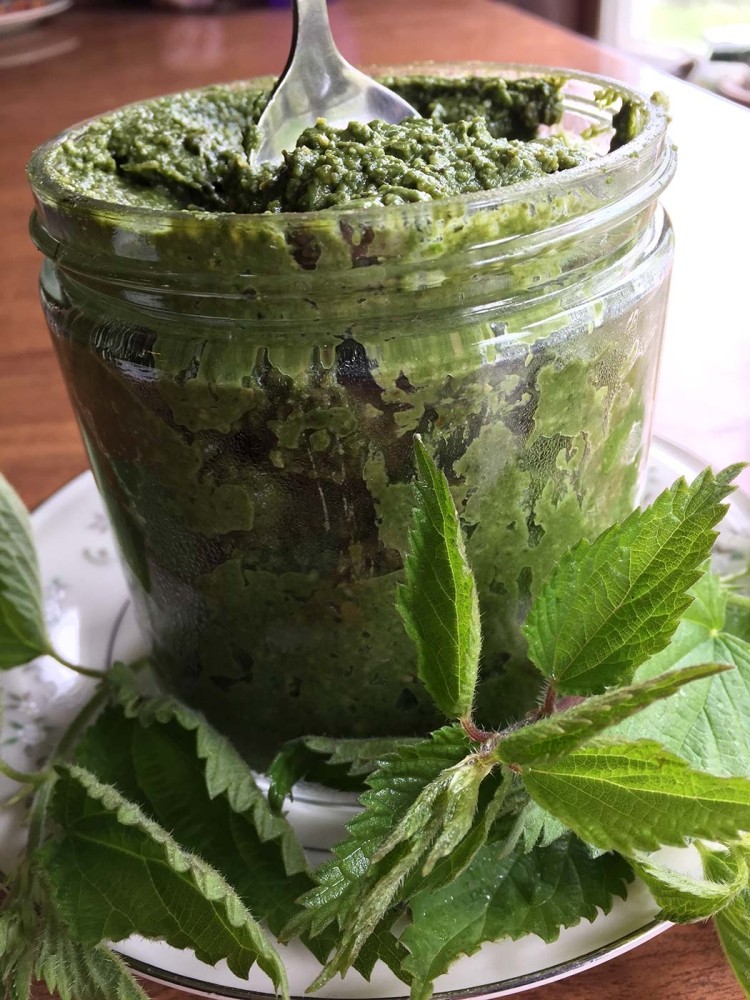While conducting wild edibles inventories on properties around western Massachusetts, environmental educator Arianna Alexsandra Collins appreciates the delight of homeowners in discovering they can forage for food in their own yard. She often couples the inventories with meal preparation and feasting workshops to foster a sense of community. Here are a few of her recipes crafted with edible plants common to the northeast, from rural to urban properties alike.
This Web Extra accompanies the article “Wild Edibles Walk-About in Your Yard,” from the Northern Woodlands Spring 2022 edition.
Spring Zing Pesto
Spring brings an array of mild and sharp greens to harvest, and pesto is a tasty addition to a wild edibles menu. Violet, stinging nettle, wood nettle, and marsh marigold tend to taste milder, whereas dandelion, toothwort, and garlic mustard each have their own delight bite. When foraging for greens to use in pesto, be sure to collect from plants that have not flowered yet (flowering plants tend to have tougher leaves). When harvesting nettles, use gloves and scissors, then steam the nettle tops for 30 seconds to wilt the leaves, rendering the sting inert. When harvesting marsh marigold, steam the leaves for about 3 minutes.
About 3 cups greens
Optional: additional 1 cup mild greens such as spinach
1/3 – ½ cup olive oil
2 cloves garlic
½ – ¾ cup nuts (your choice)
1 cup grated cheese (Parmesan, Romano or other cheese)
Salt and black pepper to taste
In food processor, combine leaves and enough oil to coat and blend. Grate 2 cloves of garlic and blend in. When the greens are well-blended (more oil may be needed), add a handful or two of your favorite nuts and/or seeds: sunflower seeds, pumpkin seeds, cashews, walnuts. Then add about a cup of your favorite cow, sheep, or goat Parmesan and/or Romano cheese. Blend well and taste test. Do you like it as is? Need a little salt? Black pepper? More cheese? More garlic? Play with the recipe to your satisfaction. Spring Zing pesto should be thick. You can eat it with crackers or spread it on rice cakes for a quick and easy spring lunch. Or if you prefer a warm dish, scoop a few spoonfuls onto your favorite cooked pasta and stir in.
Spring Lawn Salad
For a delicious complement to a spring meal, try making a salad from your lawn. Leaves are best gathered and eaten before the plants flower. If the herbaceous plants are flowering, it is best to gather the flowers, as the leaves will be tough and bitter.
Harvest and rinse a handful of each of the following: violet, dandelion, garlic mustard, lilac flowers.
Toss into your favorite spring salad greens mix. Mix in a vinaigrette dressing. Decorate with additional violet and lilac flowers on top and serve.
Vinaigrette Dressing
To make a simple vinaigrette dressing, you can mix equal portions of your favorite oil and vinegar. Add a pinch or two of Herbs de Provence. Shake. Voila. Walnut oil is an excellent choice for its flavor. Maple vinegar is a great option as well. So that you taste all the flavors of the flowers and greens, use your dressing sparely.
Flower Power Pancakes
A lovely and fun way to serve pancakes (or waffles) is to cook and top them with in-season wild edible flowers, either one species or use a few for a riot of color. Observe what edible flowers are blooming in your yard and gather 2 handfuls; 1 to stir into your batter and the other handful as a garnish. Flowers that I recommend include dandelion, violet, lilac, black locust, and rugosa rose.
1 egg
¾ cup favorite pancake mix
¼ cup shredded coconut
½ cup milk (dairy or non-dairy)
1 tsp vanilla or almond extract
1 heaping tsp fat (butter, ghee, or coconut oil)
2 handfuls flowers (1 in batter; 1 as garnish)
Cinnamon and nutmeg to taste
Oil to fry pancakes
Maple syrup or maple cream to top
My favorite gluten free pancake mix is Arrowhead Mills Organic Gluten Pancake Mix, but any pancake mix made with whatever flour or combination of flours will work well. For an extra wild touch, when the cattails are thick with pollen in the spring, you can tap the pollen into a wide bowl to collect and add as part of the dry ingredients.
Beat egg. Add milk and extract and mix. Add in dry ingredients and stir until well blended. Melt fat and stir into batter. Heat skillet and pour in a little oil to coat the bottom of the pan so that the batter doesn’t stick to the pan (my preference is olive oil). Once the oil is hot, spoon ½ cup batter per pancake into the pan and flatten slightly with a fork. When the batter is bubbly on top, flip pancakes and allow to cook another few minutes. Place pancakes on plates and garnish with maple syrup or maple cream and fresh flowers. Enjoy!
Makes 6 pancakes.




